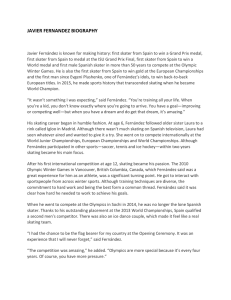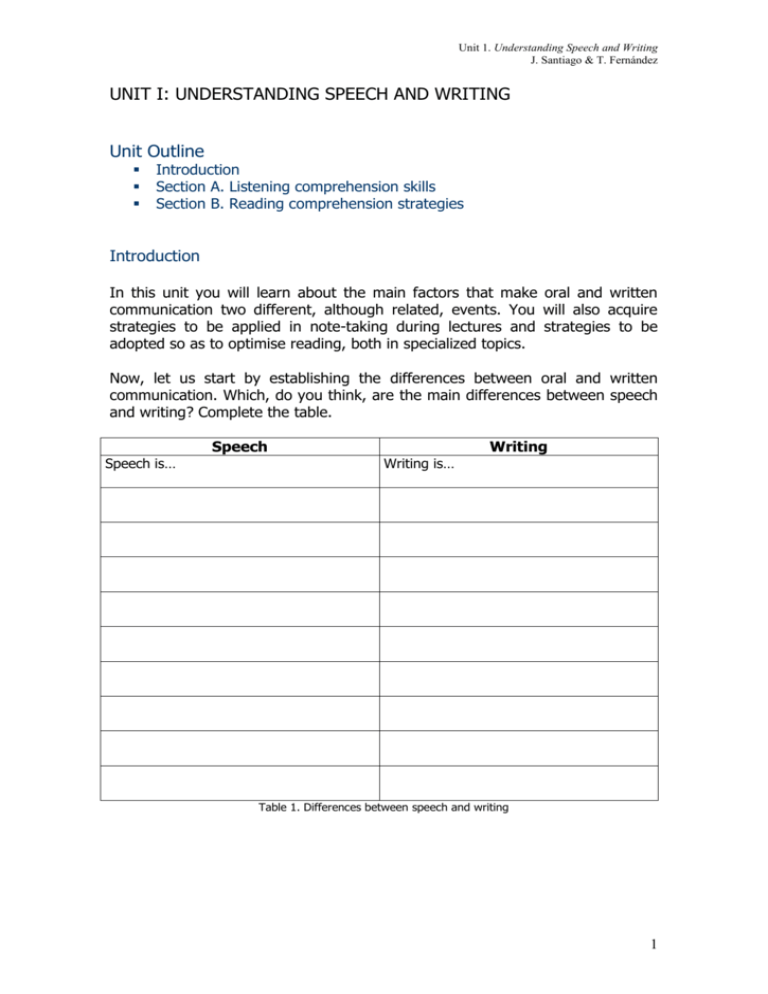
Unit 1. Understanding Speech and Writing
J. Santiago & T. Fernández
UNIT I: UNDERSTANDING SPEECH AND WRITING
Unit Outline
Introduction
Section A. Listening comprehension skills
Section B. Reading comprehension strategies
Introduction
In this unit you will learn about the main factors that make oral and written
communication two different, although related, events. You will also acquire
strategies to be applied in note-taking during lectures and strategies to be
adopted so as to optimise reading, both in specialized topics.
Now, let us start by establishing the differences between oral and written
communication. Which, do you think, are the main differences between speech
and writing? Complete the table.
Speech
Speech is…
Writing
Writing is…
Table 1. Differences between speech and writing
1
Unit 1. Understanding Speech and Writing
J. Santiago & T. Fernández
Section A. Listening comprehension techniques
Topic activation
1. How often are you exposed to oral input in English? Which sources do you
listen to?
2. Write a list with the main problems/ difficulties you encounter when listening
to oral input in English?
3. Do you apply any strategies in listening? If so, write them below.
Topic information (comprehension difficulties)
When listening to oral input in a foreign language, sometimes comprehension
can be hindered or even blocked due to different reasons:
We do not know the word.
We know the word/s but we cannot identify them.
We miss important words in the sentence, words that receive less
prominence in speech, as they act as linkers or as function elements, if
compared to main syntactic elements in the sentence that receive full
intonation focus.
We are unfamiliar with the topic and the kind of contextual elements.
2
Unit 1. Understanding Speech and Writing
J. Santiago & T. Fernández
To improve oral comprehension, there are some strategies we can adopt:
Do daily practice (20’).
o Choose topics you like, or are relevant to you, so as to pull down
affective filters that often reduce comprehension levels.
Never panic if you feel you cannot understand; in such cases, relax and
keep on listening.
Focus on what you are required to understand, not on the whole.
Do some research into the basic concepts you expect to hear and
activate the topic by contextualizing (“Googling”) important ideas.
Focus on key concepts, those which are recurrent, although they may
take different forms.
Focus on discourse functions
o The beginning, the transitions and the end so as to grasp the
general structure of the talk.
Knowing the elements (known as discourse markers or linking words) that
trigger off certain lecture transitions can greatly help identify discourse
meanings and functions. Below is a table including some of these signals &
their meaning.
Signal
Meaning
To start with, firstly…today I will speak Introducing the topic
about…today’s lecture is about…
The lecture is divided into…
Tells the structure
Firstly, secondly, next, then, last but one… Be ready for a number of points to be
listed
However, nevertheless, on the other hand,
conversely, on the contrary, despite,
nonetheless…
In addition, in other words, put another
way, also, as I mentioned before,
moreover, furthermore…
For example, that is to say, such as…
Contrast or opposing information
Especially, specifically, most importantly…
Important details will follow
Repetition, extra information or further
evidence
What follows is an example
Therefore, thus, because, consequently, Cause and effect relations
as a consequence, accordingly…
I’ll expand on this later on, I’ll give you Be alert and leave some space to build up
more detail on this….
on this point later on
Finally, in conclusion, in short, let me These signals will often help you get the
summarise, let’s recap, in brief, to wrap global picture
up…
Table 2. Discourse markers and their meanings
3
Unit 1. Understanding Speech and Writing
J. Santiago & T. Fernández
Aside from the strategies included in the table above, there are other props we
can use:
Check up key concepts/ specialized terms before listening.
Use your background knowledge, and try to link it to what you are
listening to, establish connections.
Use your knowledge of the world in general.
Re-activate your expectations about the topic. Write them in list-form,
and then see if they match.
Before listening, read questions and ensure you understand them all.
When TAKING NOTES (in lectures), we need to:
Distinguish between main and secondary ideas.
Select the most important information.
Ignore less important or ancillary details.
Identify key points and key words.
Identify the type of lecturing style and adjust your notes to it.
After listening, we need to:
Reflect on your notes.
Organize the information.
Summarize information.
Develop a critical stance.
Do multi-tasking by combining some of the above skills…
…so that the outcome from your notes is not mere copying, but a new text
showing the essential information from the source in a new personal document.
Note taking can be done in different ways: Linear/ bullet points/ listing.
Grids/tables. Diagrams and concept maps. Sometimes, the nature and purpose
of the information favours one specific way of note-taking over the rest. In all
this process, the use of abbreviations and simplified grammar may help. There
are some abbreviations in common use. However, any symbol that you adopt is
valid as long as it serves your purposes. Here are some of them:
Abbreviation
e.g.
i.e.
Et al.
N.B.
Cf.
Viz
P
Sp
Para
C20
c 1965
Meaning
For example
Id est, that is
Et altri, and the others
Nota Bene, note, important
Compare
Namely, that is to say
Page
Spelling
Paragraph
20th century
Circa, around
Table 3. Standard abbreviations
4
Unit 1. Understanding Speech and Writing
J. Santiago & T. Fernández
Section B. Reading Comprehension techniques
Topic activation
1. How do you approach reading a text? Do you adopt any strategies? Write
down your ideas.
2. Which from the following reading skills do you apply? Write a tick next to
the skills you use:
1. Identifying the rules of the sentence structure?
2. Identifying the rules of punctuation?
3. Identifying the rules governing the structure of paragraphs?
4. Identifying the relations holding between the different paragraphs?
5. Identifying the ‘glue’ words (discourse markers) that link them?
6. Identifying text organization of contents, e.g. introduction, listing…?
7. Identifying different writing styles?
8. Recognizing different text layouts, e.g. reports, journal articles…?
9. Identifying the point of view involved in a text?
10. Going for the gist (the fundamental idea/s behind the text)
11. Distinguishing between different text types, e.g. description,
narration, exposition and argumentation?*
Table 4. Summary of reading skills
* It is commonly admitted that text types can be classified into four general groups,
each with specific discourse functions and an internal structure. These types, though,
are seldom found in ‘pure state’, but rather they mix up. Common combinations are the
mixture of exposition + description, narration + description and argumentation + the
other types (that provide the grounds to support the argument). The main
characteristics of text types are:
Exposition: ‘explaining’. It is common in instructions and manuals. The order and
sequencing of parts is clearly established.
Description: ‘picturing in words’. Descriptions can be subjective or objective; they can
proceed from left-to-right/right-to-left/up-to-down/down-to-up, or go from general-tospecific/specific-to–general. Description often relies on heavy use of adjectives.
Narration: ‘retelling of events’ either real or imaginary. Narratives are mostly based on
verbal processes, that is, the use of verbs that indicate the succession of actions. The
typical internal structure of narration is: orientation-complication—resolution.
Argumentation: ‘effort to prove/refute the validity of a central thesis statement’.
Argumentative texts often follow the structure: establish thesis statement—argue
grounds-formulate logical conclusion.
5
Unit 1. Understanding Speech and Writing
J. Santiago & T. Fernández
Topic information
Reading is a complex phenomenon involving different cognitive tasks. Becoming a
trained reader partly depends on your cognitive and learning styles, and partly on the
development of certain skills that require time and effort. The pyramid structure in the
page below shows the steps to a proficient reading.
Figure 1. Steps to successful reading
Once we have acquired and developed these strategies, there are some points worth
considering. The table below elaborates on the things to do and the things to avoid
when reading.
Dos
Don’ts
Try to read fast by taking in the most
information possible. Look at words from
the corner of your eyes and/or focus your
attention on key words dispersed in the
text. Start with easy texts.
Try reading a phrase at a time, and then
move your eyes fast to the next full stop.
Read difficult sections quickly twice.
Avoid sounding out words in your head as
you read.
Avoid reading individual words.
Avoid going around difficult sections
several times.
Try to recognise new terminology
beforehand.
Approach the text with expectations
about its content, structure and type.*
Table 5. Dos and don’ts of effective reading
* In fact, most communicative exchange, be it oral or written, does not take place in a
conceptual vacuum; that would entail a great cognitive effort. A lot of what we read or
listen is incorporated into our brain structures, some preconfigured, some developed in
time through social interaction. When approaching a text for the first time, we do so
armoured with a set of expectations that activate previous knowledge and help us
recognize, assimilate and build up the new information. Some props we often draw on
when reading are:
6
Unit 1. Understanding Speech and Writing
J. Santiago & T. Fernández
The knowledge of the world, our lifetime background experience.
The knowledge of the specialized field and its terminology.
The cotext (words surrounding other words in the text).
The context of the situation.
The knowledge of similar text types (description, narrative, etc.)
The knowledge of specific discourse modes such as formal letters, curriculum
vitae, summaries, reports, PhD dissertations or project specifications.
The help of visual information.
NOW PROCEED TO THE NEXT PAGES TO DO THE TASKS
7
Unit 1. Understanding Speech and Writing
J. Santiago & T. Fernández
Practice section A. Listening to specialized topics
In this task, you have to pick up specific information. Read the questions carefully and
focus your attention on the details required. Click on the link below to watch the video.
You should be able to do the task watching the video only twice.
‘Spinning tower in Dubai’
http://www.youtube.com/watch?v=Bq-QUkE1DGM
1. What is the architect’s definition/ name for his skyscraper?
…………………………………………………………………………...
2. How many stories does it have?...............................................
3. Where is it going to be erected?.................................................
4. When is construction due to start?...............................................
5. Are there any other projects to be developed by the same architect?
Where?...............................................................................................
6. How is this skyscraper different from others?...................................
7. What is the effect of wind on skyscrapers?
……………………………………………………………………………………..
8. How will it be powered?..........................................................................
9. What is the price per foot for each condominium?....................................
10. What is new about the parking system?
…………………………………………………………………………………………………………….
11. Where will the building parks be manufactured?........................................
12. When will it be open?..................................................................................
More skyscrapers resources
http://skyscraperpage.com/
http://community.emporis.com/skyscrapers/
8
Unit 1. Understanding Speech and Writing
J. Santiago & T. Fernández
Practice section B. Reading comprehension techniques
I. Below you’ll read a selection of 4 texts. Ascribe them to the corresponding text type
or types and provide reasons to justify your choices.
On April 18, 1906, an earthquake estimated at 7.7 to 7.9 on the Ritchter scale rocked San
Francisco, killing hundreds of people as it destroyed buildings, toppled trees, twisted streets,
and broke gas and water lines. Fires broke out and developed into a firestorm. Without water,
fire fighters dynamited buildings to level a firebreak and prevent the fire from spreading. The
last flames were not extinguished until April 21. The earthquake and fire destroyed 28,000
buildings, including the homes of three quarters of the city’s population. More than 30,000
people died in the aftermath.
Text type/s:
Evidence:
Concrete is a unique material in that in can be fashioned into virtually any shape while still in
the plastic state. It will then harden in that shape with the permanence of stone.
Finishing concrete is far more complex than generally realized. To the novice, finishing is
merely the leveling and smoothing of a surface. To the qualified mechanic, finishing means
many involved procedures in a carefully timed sequence.
To achieve a quality surface, several steps are necessary. Site preparation, placing, leveling,
jointing, initial finishing, trowelling and curing.
Text type/s:
Evidence:
Call me naïve, but what I thought I saw was no more than the inevitable and unavoidable clash
between freshly quarried stone and the weathered stonework which has been exposed to
London’s malodorous atmosphere for a century and a half. Acid rain, diesel fumes and coal
smoke have severely discolored the original Portland façade. Was I surprised when I saw it?
No. Was I shocked to learn that the “inferior” French limestone had been used instead of good
old British Portland Stone? Not really (…).
Text type/s:
Evidence:
On the pleasant shore of the French Riviera, about half-way between Marseilles and the Italian
Border, stands a large, proud, rose-colored hotel. Deferential palms cool its flushed façade, and
before it stretches a short dazzling beach. Lately, it has become a summer resort of notable and
fashionable people; a decade ago, it was almost deserted after its English clientele went north in
April. In the early morning the distant image of Cannes, the pink and cream old fortifications,
the purple Alps that bounded Italy, were cast across the water and lay quavering in the ripples
sent up by sea-plants through the clear shallows.
Text type/s:
Evidence:
9
Unit 1. Understanding Speech and Writing
J. Santiago & T. Fernández
II. Work on this text about Mexico City.
1. A centre of belated attention. The huge square known as the Zocalo is no longer the beating
heart of Mexico City, as it was in Aztec times. But it is surrounded not just by a magnificent
cathedral, but by nine square km (3.5 square miles) of Spanish-colonial houses, churches and
public buildings, some dating back to the 16th century. This should be one of the most
compelling architectural destinations in the Americas. Instead, much of it is a slum of gutted
buildings, dark and dirty streets blocked by milling vendors, and garbage-strewn vacant lots.
2. The reasons for this sad decline are partly man-made, and partly natural. In the 1940s, the city
government froze rents in the city centre. Tenants paying 50 cents a week in the 1950s were still
paying the same in 1998, when the law was finally repealed. With no incentive to spend on the
upkeep, landlords let buildings disintegrate. A 1985 earthquake added to the Beirut look. The
result: 100,000 city centre residents, over a third of the total, have moved out in the last 20
years. By night, the area is almost deserted; fear of crime deters most visitors.
3. For a decade, attempts have been under way to rectify matters. Carlos Slim, Mexico’s richest
businessman, has bought up and renovated some of the old buildings to prevent their collapse.
Now the city government has started to dot its bit. Last February, it revamped the Historic
Centre Trust, a quango, endowing it with a grant of 500 pesos ($55 m).
4. The trust has begun work on renovating 34 blocks in the heart of the historic centre, behind
the cathedral. The streets are being dug up to replace the antiquated drainage system and to
improve water supply. In an innovative move, an architect has been put in charge of each of the
13 main streets, charged with restoring the facades of more than 500 buildings. The makeovers
have been designed in consultation with the residents. Last week, Andres Manuel Lopez
Obrador, the city’s left-wing mayor, also announced the start of work on a new square.
5. Further ahead, the plan is to move the street vendors out of the area, says Ana Lilia Cepeda,
the head of the Historic Centre Trust. That will be difficult: many of them bribe local officials to
be there. The overall aim is to attract new residents to the centre, and with them cafés and
restaurants—and a feeling of safety in numbers. If the promised street lighting, video cameras
and paraphernalia of modern urban security duly materialise, such gentrification may indeed
follow. After all, surely somebody will want to live in some of Latin America’s grandest
housing.
1. Skim the text to find the main idea, then write a title that summarises the essence
of its contents.
2. Underline the words or expressions you don’t know. First, if possible, try to infer
their meaning using the co-text. For those whose meanings remain unknown, use a
monolingual dictionary.
3. Write a list with 10 key words that act as focal meaning elements in the content.
4. Divide the text into content/meaning sections, such as introduction, exemplification,
arguing grounds or reasons, conclusions, etc. and indicate the paragraphs.
5. The text is rich with the idea of “decline”; look for all the words and expressions that
build this idea in the text.
10
Unit 1. Understanding Speech and Writing
J. Santiago & T. Fernández
References
Alcaráz, E. 2007. El inglés profesional y académico. Madrid: Alianza Editorial.
Baily, S. 2006. Academic Writing. A handbook for International Students. London and
New York. Routledge.
Camino Olea, M.S. 2001. Diccionario de Arquitectura y Construcción. Madrid: MunillaLería. Elaborado a partir del Banco de Términos de la Edificación (BANTE).
Construpedia: http://www.construmatica.com/construpedia/Portada
Chung, T.M. and P. Nation. 2003. “Technical vocabulary in specialized texts.” Reading
in
a
Foreign
Language
15(2),
103–116.
http://nflrc.hawaii.edu/rfl/October2003/chung/chung.html. Accessed 15 May
2008.
Harris, C.M. 2000. Dictionary of Architecture and Construction. MacGraw-Hill.
Grice, G. and P. Maier. 2007. Effective Study Skills. Unlock your Potential. Pearson
Longman: Harlow.
Maclean, J.H. and J.S. Scott. 1995. The Penguin Dictionary of Building. Penguin.
Sanabria, K. 2004. Academic Encounters in Society. Listening, Note Taking, Discussion.
Cambridge University Press.
Santiago, J. and T. Fernández. 2010. Notes from Class (2000-2010). Unpublished.
Wallace, J. M. 2004. Study skills in English. Cambridge University press.
11

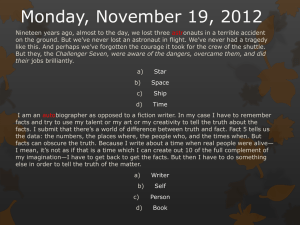
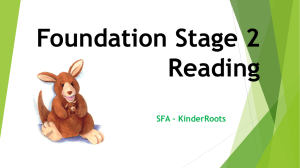
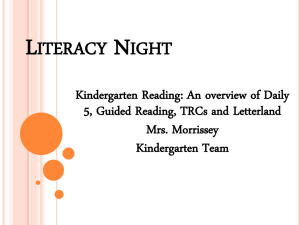
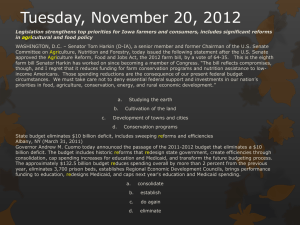
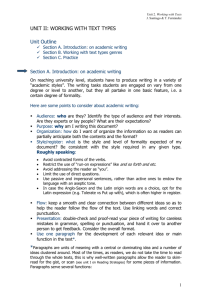


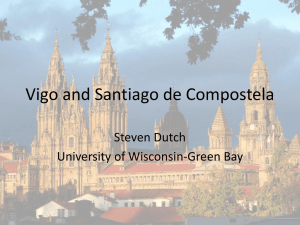


![final mark [___]](http://s3.studylib.net/store/data/006884513_1-7612f20c2c220e9f22ba6fb4dc73aa5a-300x300.png)
